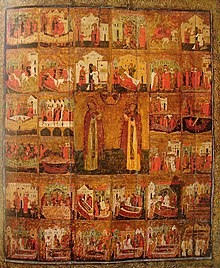The Tale of Peter and Fevronia
 |
|
| Author | |
|---|---|
| Original title | Повесть о Петре и Февронии Муромских |
| Translator | Serge Zenkovsky |
| Country | Russia |
| Language | Russian |
| Genre | Tale, hagiography |
|
Publication date
|
mid-16th century |
The Tale of Peter and Fevronia of Murom (Russian: Повесть о Петре и Февронии Муромских, Povest o Petre i Fevronii Muromskikh) is a 16th-century Russian tale by Hermolaus-Erasmus, often referred to as a hagiography.
Apanage prince Paul (Russian: Павел) is disturbed, as a guileful snake has gotten into the habit of visiting his wife disguising himself as the prince. His wife finds out that the only man who can defeat the snake with a magiс sword is Paul's brother, Peter (Russian: Пётр). Peter defeats the snake, but its blood spills on him and his body is covered with aching scabs. No doctors can help, but suddenly Peter hears of Fevronia (Russian: Феврония), a wise young peasant maiden, who promises to heal him. As a reward she wants to marry Peter. When healed, he does not keep his promise and instead sends rich gifts to Fevronia. However, soon Peter's body is again covered with scabs. Fevronia heals him again and this time they get married. Prince Paul soon dies and Peter and Fevronia come to reign in Murom. The boyars are unhappy to have a peasant woman for princess, and they ask Fevronia to leave the city taking with her whatever riches she wants. Fevronia agrees, asking them to let her choose just one thing. The boyars find out that the wise maiden's wish was to only take her husband, so Peter and Fevronia leave Murom together. The city remains without a prince. The boyars start strifes over the reign, Murom is in havoc, and finally Peter and Fevronia are asked to return. They reign wisely and happily until their last days, which they spend in monasteries. They know they will die on the same day and ask to be buried in the same grave. The Russian Orthodox tradition does not allow for a monk and a nun to be buried together, but the bodies are twice found to disappear from the original coffins and finally remain in the common grave forever.
...
Wikipedia
